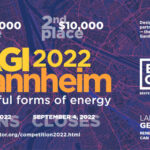Submission: May 15, 2016
Registration: April 15, 2016
Language: English
Location: Santa Monica, USA
Prizes: 1st Prize: 15000$, 2nd Prize: 4000$
Type: Open
LAGI 2016 invites creatives, scientists, engineers, and others from around the world to submit ideas for large-scale and site-specific public art installations that generate carbon-neutral electricity and/or drinking water for the City of Santa Monica, California.
The competition is free and open to everyone. We encourage designers, artists, engineers, architects, landscape architects, university students, urban planners, scientists, and anyone to enter who believes that the world can be powered beautifully and sustainably. There is a cash prize of $15,000 for the 1st Place winner and $4,000 for the 2nd Place winner.
Please take a moment to click on the “register” link in the sidebar and create an account. By doing so, you will stay informed as there are updates.
DESIGN GUIDELINES
- Designs must not exceed 80 meters in height (2x the height of the Pacific Ferris Wheel)
- Be designed specifically to the constraints of the design site at the Santa Monica Pier as shown in the Location Plan (available for download). Designs can (but are not required to) allow visitors to walk within the project boundary;
- Be safe to people who would view it. Consideration must be made for viewing platform spaces and boundaries between public and restricted areas. Boats can access the area around the breakwater, but swimming out to, or near the existing breakwater is prohibited;
- Be well informed by a thorough understanding of the history, geography, restrictions, and details of the design site, and the broader surrounding and regional contexts;
- Not create greenhouse gas emissions and not pollute. The work must not impact the natural surroundings negatively. Each entry must provide a brief (approximately 300 words) environmental impact assessment as a part of the written description. The statement should include a list of the effects of the project on the natural ecosystem and should propose a mitigation strategy to address them;
- Be pragmatic and constructable, employing technologies that can be scalable and tested. There is no limit on the type of technology that is specified. It is recommended that the design team make an effort to engage the owners of proprietary technology in preliminary dialogue as a part of their own research and development of the design entry. The more pragmatic the proposals are, the greater the likelihood will be that one of them may get built;
- Convert natural energy into electricity and/or drinking water at the site. The artwork must have the ability to store, and/or transform and transmit the electrical power it generates to a grid connection point to be designed by others. Consideration should be made for artfully housing the required transformer and electrical equipment (balance of system) within the project boundary and restricting access to those areas for the safety of visitors to the site. Similar considerations should be made for drinking water production and transmission technology if incorporated;
- Consist of a three dimensional sculptural form that has the ability to stimulate and challenge the minds of visitors to the site. The work should aim to solicit contemplation from viewers on such broad ideas as ecological systems, human development and habitation, energy and water resource consumption and production, and/or other concepts at the discretion of the design team;
- Entries must be in English.
PARTICIPATION
As an international design competition, the Competition is open worldwide to professionals, any member of the public, and to students. An Entrant may either make a Submission individually or as a team (“Entrant”). Each team shall identify one team member as its Point of Contact (“Point of Contact”) during the upload process.
The following are excluded from participation in the competition:
- All persons or businesses who are or were involved in the organization of the competition or have contributed significantly to formulating the competition design guidelines.
- Representatives or employees of the competition promoter.
- Employees with or partners of any member of the jury or adviser to the jury.
- Persons who are close relatives of or have a close familial relationship with any member of the jury or adviser to the jury.
- Enterprises that are wholly or partly owned by persons who are close relatives of or have a close familial relationship with a member of the jury or adviser to the jury.
- Any employee, volunteer, or board member of Society for Cultural Exchange or the Land Art Generator Initiative.
No matter how a person is involved in the preparation of an entry, he or she must be aware of the above rules. In case of doubt, contact lagi@landartgenerator.org.
SCE shall direct all Competition-related communications to the Point of Contact. Any awarded prize funds shall be distributed to the Point of Contact of the winning Entrant.
A team (Entrant) may be composed of a group of otherwise unaffiliated individuals and/or represent an existing organization, firm, or agency. There are no age restrictions.
PRIZES
First Place: $15,000 (USD) Two members of the first place winning team will be flown to Los Angeles for the award ceremony and exhibition opening. Accommodations and airfare will be provided, but Visas and other travel requirements are the responsibility of the team members.
Second Place: $4,000 (USD)








